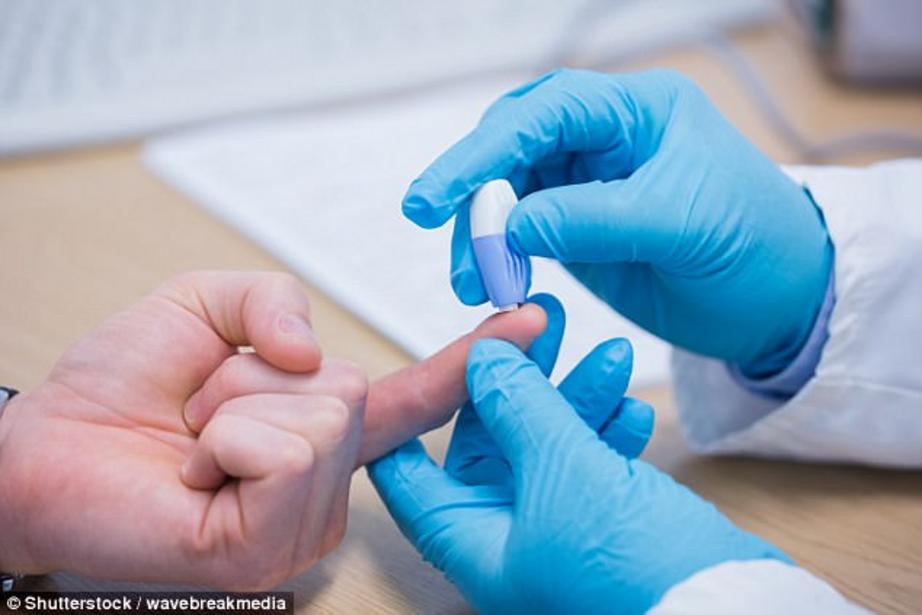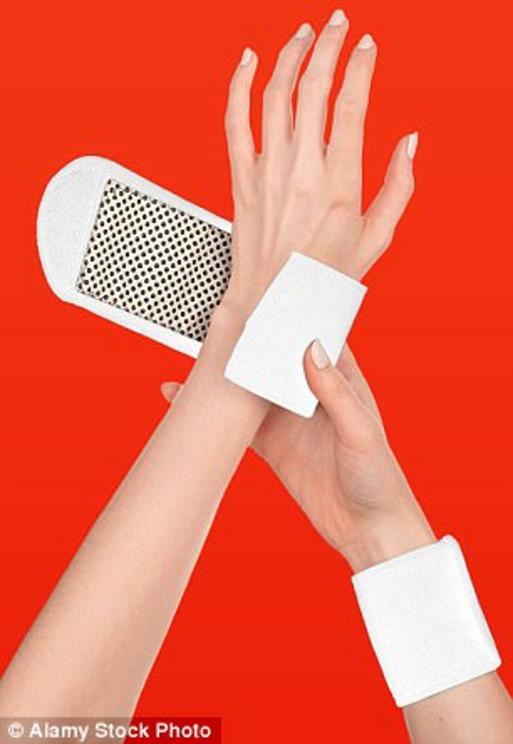Sweatband to replace finger-prick test for diabetes by transmitting data on blood sugar levels to handheld device
- Scientists have designed a new sweatband to replace the painful finger-pricking
- The device will help people who need to check their blood sugar multiple times
- A study has shown that the new device measures as accurately as a standard one
Scientists say that they have designed a new sweatband which accurately measures blood sugar levels and could replace the painful finger-prick
Scientists have designed a sweatband that can measure blood sugar levels without the need for painful finger-prick tests.
The device is worn on the upper arm and contains sensors that measure blood sugar levels via sweat on the skin’s surface. It transmits the data to a hand-held device, with a digital display of the levels.
A recent small study showed the device measured blood sugar levels as accurately as a standard blood test.
It has been developed for people with diabetes who need to regularly check their blood sugar levels — this may involve between four and ten finger-prick tests a day. The results help them work out how much medicine they need to control blood sugar levels.
Poor control can lead in the long-term to complications such as cardiovascular and kidney diseases, vision problems, and damage to nerves from excess sugar in the blood.
A number of patches and sensors have been developed to overcome some of the downsides of repetitive injections, but they mostly need blood samples or are made of more than one complicated component. For example, a device called FreeStyle Libre, worn by Theresa May, is a patch that is worn continuously on the upper arm to monitor glucose levels in fluid between cells — the wearer also needs a separate device to ‘read’ the results from the patch.
The new device is not worn continuously, but is put on when it’s needed.
It has specially-designed sensors to measure sugar levels in the sweat. The body has more than two million sweat glands that constantly produce sweat, even at rest or while we’re asleep. This sweat naturally contains glucose and can mirror the level of sugar in our blood.
Once on the skin, the device takes about 15 minutes for enough sweat — as little as one millionth of a litre — to build up on the sensor so that blood sugar levels can be measured.
The results are automatically analysed and displayed on a handheld device. It is designed to be used at set intervals throughout the day, when patients would usually take a finger-prick test.
In a very small study published in the journal Science Advances, where three people’s blood sugar levels were compared before and after a meal, the sweatband was shown to be as effective as a conventional finger-prick blood test.
Its developers, based at Seoul National University in South Korea, say it can also have tiny needles built into it and, depending on the blood sugar reading, these can then deliver the correct amount of blood sugar-lowering medication. Dr Paul Jenkins, a consultant endocrinologist at The London Endocrine Centre, said: ‘This is a potentially interesting advance in the management of diabetes. If further large-scale studies validate the claims it will be very useful and popular among patients.
Nevertheless I have doubts about the additional claim of being able to automatically calculate and inject the appropriate dose of medication.’
 At the moment, diabetes sufferers mainly use finger-pricks to measure their blood sugar levels, meaning that some people prick their finger up to 10 times a day
At the moment, diabetes sufferers mainly use finger-pricks to measure their blood sugar levels, meaning that some people prick their finger up to 10 times a day
Meanwhile, up to a third of type 2 diabetes cases could be prevented with regular exercise, according to a study in the British Journal of Sports Medicine.
Researchers monitored 44,000 people from 1996 and found the risk of developing type 2 diabetes declined with increasing levels of exercise. Those who reported doing the most vigorous exercise were least likely to develop it.
Up to 30 per cent of type 2 diabetes cases could be avoided if inactive people engaged in the levels of activity recommended by the World Health Organisation, say the researchers. One theory is that exercise makes muscles more sensitive to insulin, the chemical signal that tells cells to absorb glucose from the blood.
For the rest of this article please go to source link below.
Video can be accessed at source link below.

